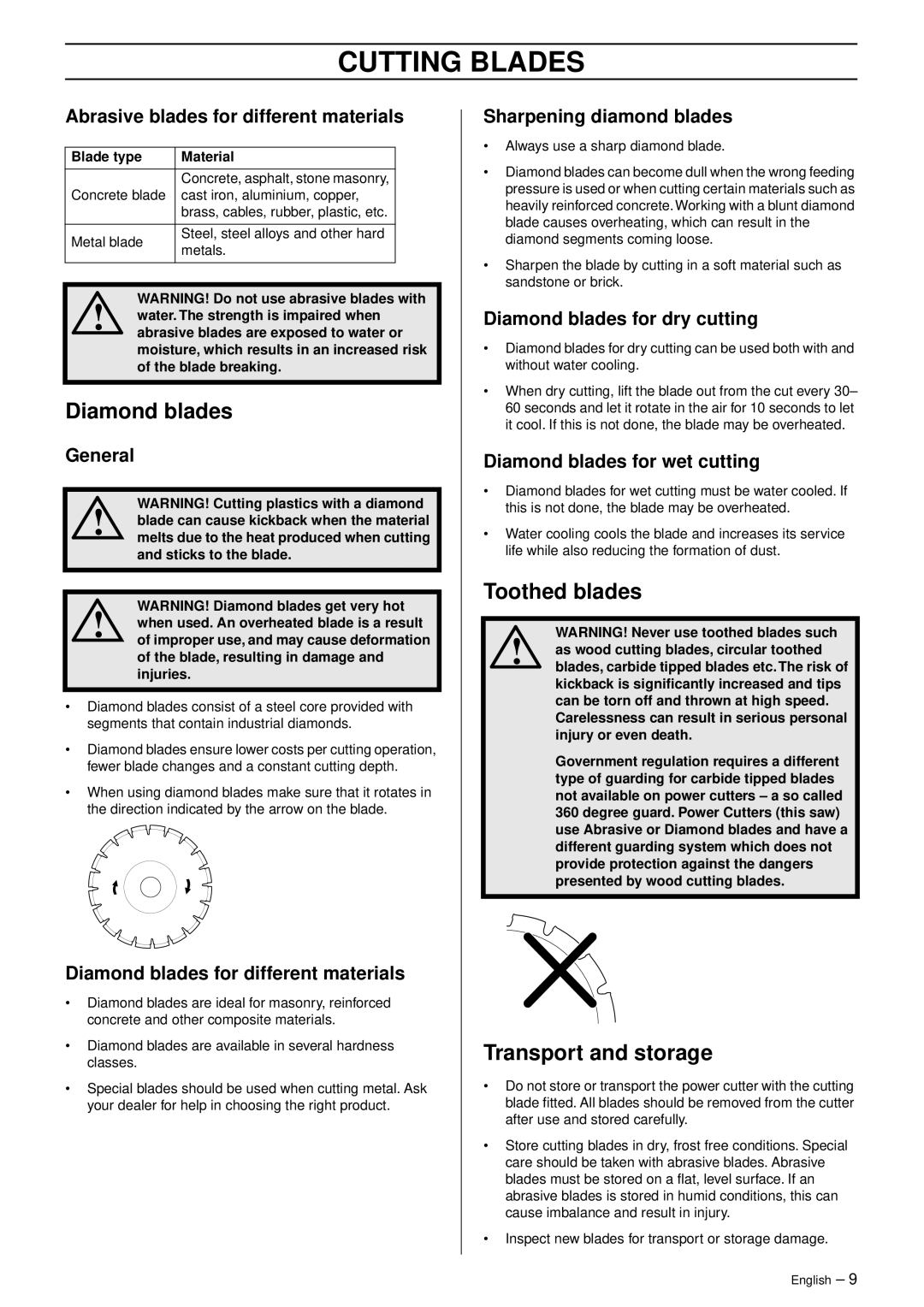
CUTTING BLADES
Abrasive blades for different materials
Blade type | Material | |
|
| |
| Concrete, asphalt, stone masonry, | |
Concrete blade | cast iron, aluminium, copper, | |
| brass, cables, rubber, plastic, etc. | |
|
| |
Metal blade | Steel, steel alloys and other hard | |
metals. | ||
| ||
|
|
! | WARNING! Do not use abrasive blades with |
water. The strength is impaired when | |
abrasive blades are exposed to water or | |
| moisture, which results in an increased risk |
| of the blade breaking. |
Diamond blades
General
WARNING! Cutting plastics with a diamond
!blade can cause kickback when the material melts due to the heat produced when cutting and sticks to the blade.
WARNING! Diamond blades get very hot
!when used. An overheated blade is a result of improper use, and may cause deformation of the blade, resulting in damage and injuries.
•Diamond blades consist of a steel core provided with segments that contain industrial diamonds.
•Diamond blades ensure lower costs per cutting operation, fewer blade changes and a constant cutting depth.
•When using diamond blades make sure that it rotates in the direction indicated by the arrow on the blade.
Diamond blades for different materials
•Diamond blades are ideal for masonry, reinforced concrete and other composite materials.
•Diamond blades are available in several hardness classes.
•Special blades should be used when cutting metal. Ask your dealer for help in choosing the right product.
Sharpening diamond blades
•Always use a sharp diamond blade.
•Diamond blades can become dull when the wrong feeding pressure is used or when cutting certain materials such as heavily reinforced concrete. Working with a blunt diamond blade causes overheating, which can result in the diamond segments coming loose.
•Sharpen the blade by cutting in a soft material such as sandstone or brick.
Diamond blades for dry cutting
•Diamond blades for dry cutting can be used both with and without water cooling.
•When dry cutting, lift the blade out from the cut every 30– 60 seconds and let it rotate in the air for 10 seconds to let it cool. If this is not done, the blade may be overheated.
Diamond blades for wet cutting
•Diamond blades for wet cutting must be water cooled. If this is not done, the blade may be overheated.
•Water cooling cools the blade and increases its service life while also reducing the formation of dust.
Toothed blades
! | WARNING! Never use toothed blades such |
as wood cutting blades, circular toothed | |
blades, carbide tipped blades etc. The risk of | |
| kickback is significantly increased and tips |
| can be torn off and thrown at high speed. |
| Carelessness can result in serious personal |
| injury or even death. |
Government regulation requires a different type of guarding for carbide tipped blades not available on power cutters – a so called 360 degree guard. Power Cutters (this saw) use Abrasive or Diamond blades and have a different guarding system which does not provide protection against the dangers presented by wood cutting blades.
Transport and storage
•Do not store or transport the power cutter with the cutting blade fitted. All blades should be removed from the cutter after use and stored carefully.
•Store cutting blades in dry, frost free conditions. Special care should be taken with abrasive blades. Abrasive blades must be stored on a flat, level surface. If an abrasive blades is stored in humid conditions, this can cause imbalance and result in injury.
•Inspect new blades for transport or storage damage.
English – 9
